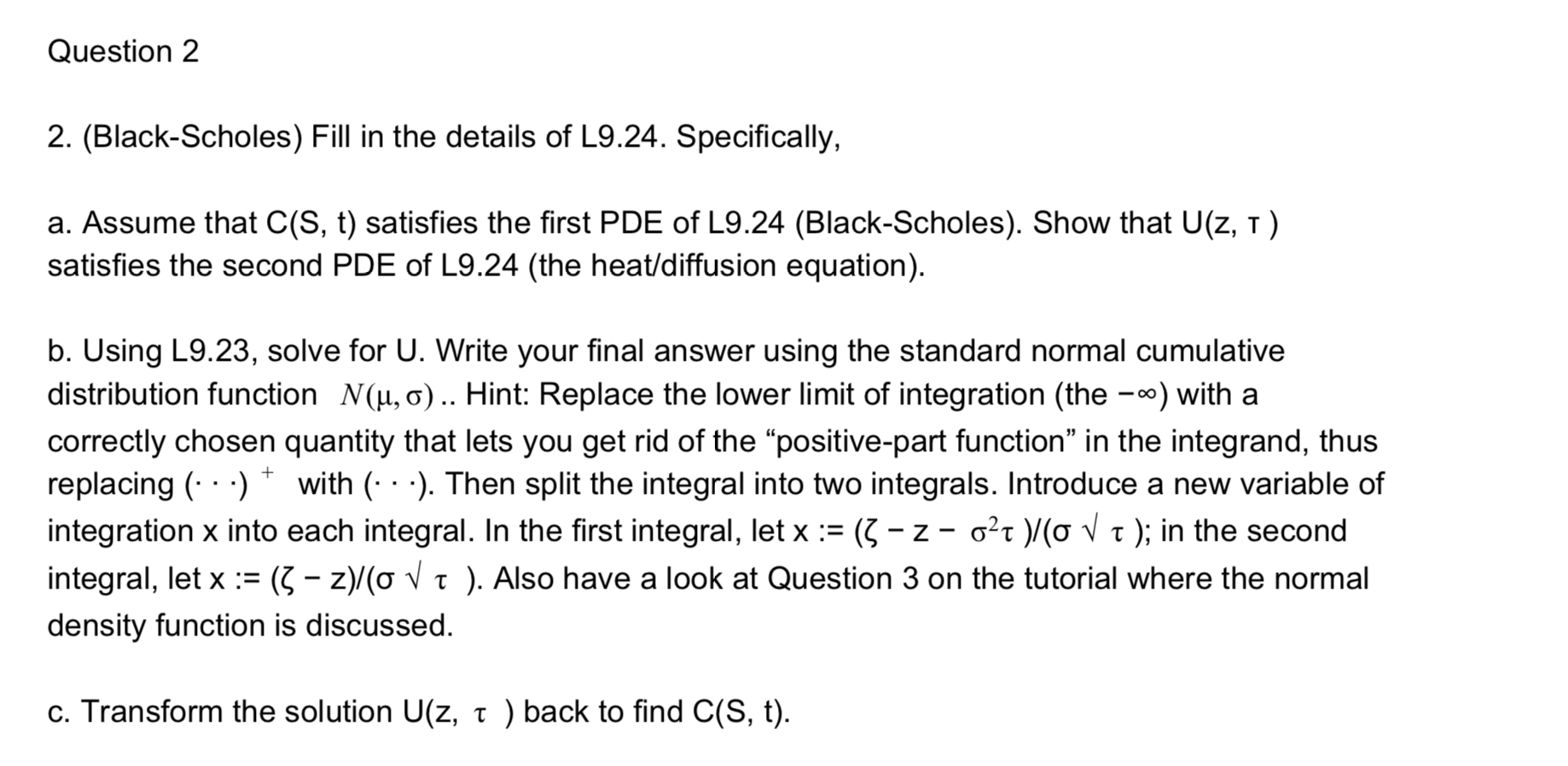Answered step by step
Verified Expert Solution
Question
1 Approved Answer
NEED HELP WITH 2B AND 2C PLEASE DO NOT COPY OTHER QUESTION'S ANSWERS THEY ARE INCORRECT THANKS Question 2 2. (Black-Scholes) Fill in the details

 NEED HELP WITH 2B AND 2C PLEASE DO NOT COPY OTHER QUESTION'S ANSWERS THEY ARE INCORRECT
NEED HELP WITH 2B AND 2C PLEASE DO NOT COPY OTHER QUESTION'S ANSWERS THEY ARE INCORRECT
THANKS
Question 2 2. (Black-Scholes) Fill in the details of L9.24. Specifically, a. Assume that C(S, t) satisfies the first PDE of L9.24 (Black-Scholes). Show that U(z, T) satisfies the second PDE of L9.24 (the heat/diffusion equation). + b. Using L9.23, solve for U. Write your final answer using the standard normal cumulative distribution function N(u, o).. Hint: Replace the lower limit of integration (the -) with a correctly chosen quantity that lets you get rid of the positive-part function in the integrand, thus replacing (...) with (...). Then split the integral into two integrals. Introduce a new variable of integration x into each integral. In the first integral, let x := (5 - 2 - )/(0 V ); in the second integral, let x := (5 z)/(o V ). Also have a look at Question 3 on the tutorial where the normal density function is discussed. c. Transform the solution U(z, 1 ) back to find C(S, t). L9.23 Intuition of the diffusion kernel 1 The (z 5)2 ] exp V27027 2027 S is sometimes called the diffusion kernel" or "fundamental solution or Greens function for the diffusion PDE. Intuition: op{- 17 { This is the Normal(5,02T) density. Regard the initial unit mass at as many many particles each following a Brownian motion. Alternative derivation: let 5 = 0. Note that if U(2, 1) solves the PDE, then so does U(cz, c-7). So look for a solution U(z,T) = otaul). Plug into PDE to produce an ODE for u, and solve. Question 2 2. (Black-Scholes) Fill in the details of L9.24. Specifically, a. Assume that C(S, t) satisfies the first PDE of L9.24 (Black-Scholes). Show that U(z, T) satisfies the second PDE of L9.24 (the heat/diffusion equation). + b. Using L9.23, solve for U. Write your final answer using the standard normal cumulative distribution function N(u, o).. Hint: Replace the lower limit of integration (the -) with a correctly chosen quantity that lets you get rid of the positive-part function in the integrand, thus replacing (...) with (...). Then split the integral into two integrals. Introduce a new variable of integration x into each integral. In the first integral, let x := (5 - 2 - )/(0 V ); in the second integral, let x := (5 z)/(o V ). Also have a look at Question 3 on the tutorial where the normal density function is discussed. c. Transform the solution U(z, 1 ) back to find C(S, t). L9.23 Intuition of the diffusion kernel 1 The (z 5)2 ] exp V27027 2027 S is sometimes called the diffusion kernel" or "fundamental solution or Greens function for the diffusion PDE. Intuition: op{- 17 { This is the Normal(5,02T) density. Regard the initial unit mass at as many many particles each following a Brownian motion. Alternative derivation: let 5 = 0. Note that if U(2, 1) solves the PDE, then so does U(cz, c-7). So look for a solution U(z,T) = otaul). Plug into PDE to produce an ODE for u, and solveStep by Step Solution
There are 3 Steps involved in it
Step: 1

Get Instant Access to Expert-Tailored Solutions
See step-by-step solutions with expert insights and AI powered tools for academic success
Step: 2

Step: 3

Ace Your Homework with AI
Get the answers you need in no time with our AI-driven, step-by-step assistance
Get Started


